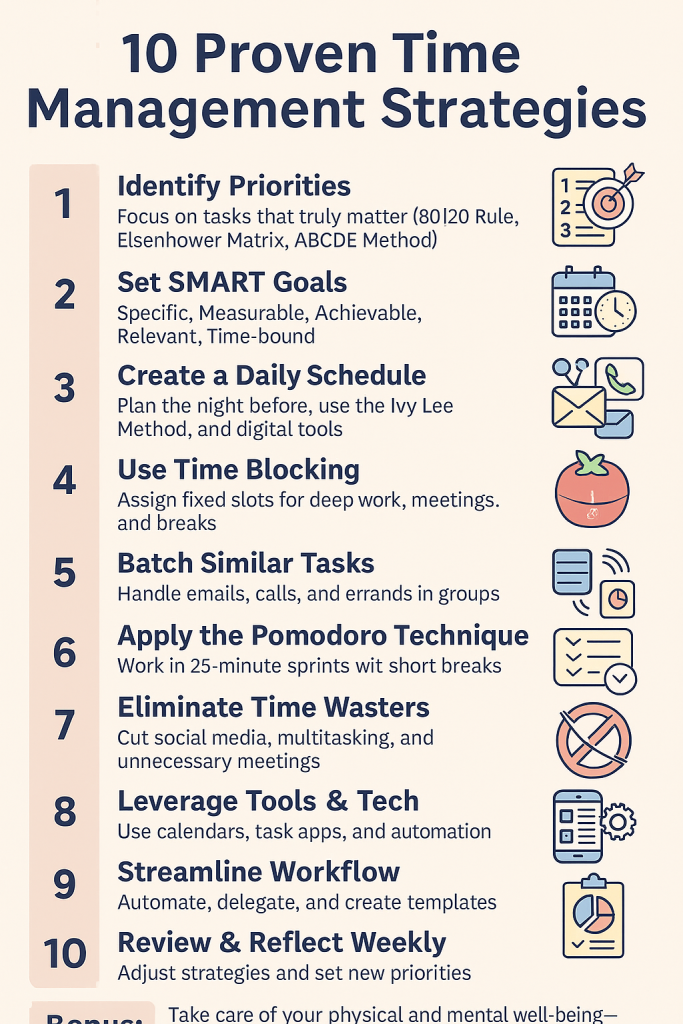10 Proven Time Management Strategies to Make Time for Your Priorities
You’re busy—meetings, emails, errands, and a million tasks. Still, it seems like there isn’t enough time for your goals and priorities. You check off items on your to-do list, but you feel like you haven’t accomplished much at the end of the day.
It’s really frustrating when you work hard but see little results. But there’s a better way to use your hours. A few tweaks in daily life can free up several hours a week.
This post shares 10 time management strategies to help you align your time with your real priorities and be more productive. These will help you get more done while staying focused on what matters.
Why Strategic Time Management Matters
Being busy doesn’t mean you’re productive. You can fill your day with tasks, but achieve little. Here, strategic time management helps. It helps you focus on high-impact activities, not just being busy.
Managing your time purposely increases productivity. You accomplish more of the important tasks, meet deadlines without stress, and maintain mental clarity. Tasks that once felt overwhelming become manageable because your hours are structured and intentional.
Time is your most valuable resource, and it’s non-renewable. Every minute you spend on low-priority work is a minute you’ll never get back. Effective time management means that the hours you have are spent on what really matters, whether at work, on personal projects, or for your overall well-being.
By understanding the difference between being busy and being productive, you can make conscious choices, minimize waste, and reclaim control of your day.
10 Proven Time Management Strategies
Effective time management occurs when you plan and utilize your hours efficiently. Here are the strategies to focus on essential tasks, minimize waste, and achieve results.
1. Identify Your Priorities
The first step in time management is to determine what truly matters. Without clarity, you can get lost in low-value tasks and remain busy without results.
Here are several prioritization techniques you can use to pinpoint your top priorities:
- Pareto Principle (80/20 Rule): Focus on the 20% of tasks that deliver 80% of the results. This ensures your energy is spent on high-impact activities.
- Eisenhower Matrix: Sort tasks into categories of urgent and important. Focus on what drives your long-term goals, rather than just reacting to immediate demands.
- ABCDE Method: Rank tasks by importance—from “A” (must do) to “E” (eliminate or delegate). This method gives a clear daily roadmap.
Aligning daily tasks with long-term goals means every action contributes to your bigger goals. You can review your weekly goals each Sunday and choose 3-5 tasks each day supporting the goals.
Pro Tip: Start your day by writing your top 3 priorities on paper before you open email. This keeps you focused on meaningful work rather than reactive tasks.
Further Reading: How to Prioritize Tasks and Manage Time Effectively
2. Set SMART Goals
Clear goals guide your time and energy. Without them, even the most productive day can feel aimless. SMART goals provide structure, turning vague intentions into actionable steps.
SMART stands for:
- Specific: Define exactly what you want to achieve.
- Measurable: Track progress with clear criteria.
- Achievable: Set realistic objectives within your resources.
- Relevant: Ensure the goal aligns with your priorities.
- Time-bound: Assign a deadline to stay accountable.
Setting goals in this way gives your daily schedule direction. For example, instead of saying “exercise more,” frame it as “walk 30 minutes, five days a week.” Instead of “improve work efficiency,” try “complete project X two days before the deadline this month.”
Pro Tip: Reframe vague goals into SMART format at the start of each week. This makes it easier to prioritize tasks and measure progress.
Further Reading: Goal Setting 101: Steps, Techniques, Examples, and Mistakes
3. Create a Daily Schedule
Planning your day gives you clarity and keeps stress at bay. Spend a few minutes the night before organizing tasks, and you’ll start the day right.
Here are a few ways for daily scheduling:
- Ivy Lee Method: List the 6 most important tasks for the next day, order them by priority, and complete one at a time.
- Digital tools and calendars: Use Google Calendar, Todoist, or other apps to schedule time and set reminders.
- Time slots for tasks and breaks: Schedule specific times for focused work, meetings, and short breaks to stay energized.
Pro Tip: Take 10 minutes each evening to plan tomorrow’s schedule— it clears your mind and sets you up for the day.
Further Reading: How to Plan Your Day for Success: A Step-by-Step Guide
4. Use Time Blocking
Time blocking turns a to-do list into a schedule. By assigning specific hours to tasks, you ensure that your top priorities receive the necessary attention. Instead of letting your day get hijacked by distractions or low-value work, you carve out time for focused work.
Schedule calendar slots for top priorities. Decide what’s most important each day and schedule blocks of time for them in your calendar. Treat blocks as non-negotiable appointments.
Example schedule:
- 9:00–10:00 AM = Check and respond to emails
- 10:00 AM–12:00 PM = Deep work on project tasks
- 1:00–2:00 PM = Team meetings
- 2:30–4:00 PM = Creative work or planning
Time blocking reduces context switching, allowing your brain to stay focused for longer and produce better results. Over time, it trains you to respect your own schedule and use every hour intentionally.
Pro Tip: Treat your time blocks as non-negotiable appointments with yourself. This simple discipline helps keep distractions at bay and boosts productivity.
Further Reading: Time Blocking 101: Everything to Get Started with This Method
5. Batch Similar Tasks Together
Grouping similar tasks reduces the mental load of constantly switching between activities. When you batch tasks, your brain stays in one mode, which saves time and energy. Instead of spreading small tasks throughout the day, tackle them in focused blocks of time.
Grouping similar tasks reduces the mental load of constantly switching between activities. When you batch tasks, your brain stays in one mode, which saves time and energy. Instead of spreading small tasks throughout the day, do them in focused blocks of time.
Ways to batch tasks effectively:
- Emails: Set specific times to check and respond, rather than checking and responding throughout the day.
- Phone calls: Make all your calls in one session.
- Errands: Group errands together to avoid repeated trips.
- Routine administrative work: Handle routine tasks, such as invoicing or reporting, in one block.
Batching reduces distractions, lowers stress, and improves efficiency. It also frees up larger chunks of time for deep work or high-priority projects.
Action Step: Identify three small but recurring tasks you do daily and schedule them together in a single time block this week.
Further Reading: How to Work Faster: Tips for Boosting Productivity
6. Use the Pomodoro Technique
The Pomodoro Technique is a simple way to boost focus and productivity. It breaks work into short and timed intervals called “Pomodoros.” It’s typically 25 minutes of focused work followed by a 5-minute break. This rhythm keeps your mind sharp and prevents burnout.
Here’s how to apply the technique:
- Work in focused sprints: Set a timer for 25 minutes and fully concentrate on one task.
- Take short breaks: Step away from your desk for 5 minutes to give your brain a rest.
- Longer breaks: After four Pomodoros, take a 15–30 minute long break to recharge.
- Adjust as needed: Some people prefer 50-minute work sessions with 10-minute breaks; experiment to find what works best for you.
Using this method helps you maintain high levels of focus, track the time it takes to complete tasks, and create a sense of urgency that reduces procrastination. It’s also a great way to balance deep work with rest periods throughout the day.
Action Step: Start your day with two Pomodoros for your most important task before checking emails or messages.
Check Out: The Ultimate Guide to the Pomodoro Technique (with Variations & Tools)
7. Eliminate Time Wasters
Small things can steal hours from your day. Social media, unnecessary meetings, and constant notifications can make you feel busy but achieve little. Identifying and eliminating these time wasters is key to focused work.
Ways to cut down on wasted time:
- Digital distractions: Turn off non-essential notifications and set specific times to check emails or social media. Studies show it can take over 20 minutes to regain focus after an interruption.
- Avoid multitasking: Switching between tasks reduces efficiency and increases mental fatigue. Focus on one task at a time.
- Eliminate meetings: Only attend meetings with clear agendas. If a quick chat or email can replace it, skip the meeting.
- Learn to say no: Protect time for high-value activities by declining requests that don’t align with your priorities.
Eliminating time wasters frees up mental space and energy for meaningful work. Even small adjustments—like checking emails twice a day instead of constantly—can add hours to your week.
Pro Tip: Schedule “focus blocks” in your calendar where notifications are off and colleagues know not to disturb you.
Check Out: Common Time Wasters at Work and How to Avoid Them
8. Utilizing Tools and Technology
Technology can make time management so much easier when used intentionally. The right tools help you organize tasks, track progress, and stay on top of deadlines. Rather than relying on memory, these tools create structure and free up mental space for high-priority work.
Ways to use tools effectively:
- Task management apps: Some tools like Trello, Todoist, or Asana help you organize and prioritize tasks visually.
- Digital calendars: In Google Calendar or Outlook, you can schedule time blocks, set reminders, and prevent overbooking.
- Automation tools: Automate repetitive tasks such as scheduling emails, generating reports, or posting social media content.
- Note-taking apps: Utilize apps like Evernote or Notion to consolidate ideas, tasks, and project notes in one location.
Using technology strategically ensures that your focus stays on meaningful work rather than low-value tasks. It also makes reviewing your progress and planning ahead faster and easier.
Action Step: Choose one tool today—such as a task manager or digital calendar—and schedule your top three priorities for the next day.
Find a Tool: The Best Time Management Tools for Every Need
9. Streamline Your Workflow
Simplification and optimization of tasks make you more efficient. Streamlining your workflow reduces repetition and decision fatigue, freeing up time for high-value work.
Ways to streamline your workflow:
- Automate repetitive tasks: Use software for scheduling, data entry, or report generation to save hours each week.
- Create templates and checklists: Standardize emails, reports, or project steps to work faster and more consistently.
- Delegate effectively: Identify tasks others can do, provide clear instructions, and free your time for work only you can handle.
- Batch approvals or reviews: Consolidate decision-making processes to minimize interruptions and streamline workflow.
A streamlined workflow means your day flows smoothly, you waste less time, and your productivity is more predictable. Small changes add up to significant time savings over the course of weeks and months.
Action Step: Choose one repetitive task this week and either automate it, create a template, or delegate it to someone else.
10. Review and Reflect Weekly
Reviewing helps you understand what’s working, what’s not, and where your time is spent. Without reviewing, even the best strategies can lose effectiveness over time. A weekly check-in keeps your goals and priorities aligned with your daily actions.
Ways to review and reflect:
- Assess completed tasks: Compare what you planned versus what you actually accomplished.
- Analyse time spent: Identify where you lost focus or spent too much time on low-value tasks.
- Adjust strategies: Refine your time management methods based on what worked and what didn’t.
- Set next week’s priorities: Choose key tasks that align with long-term goals and schedule them first.
Taking time to reflect gives you clarity, reduces wasted effort, and ensures your productivity continues to improve.
Pro Tip: Set aside 30 minutes every Sunday to review your past week, track progress, and plan your top priorities for the coming week.
Further Reading: How to Plan Your Week Effectively: A Step-by-Step Guide
Bonus Strategy: Physical and Mental Well-being
Your productivity depends on both your mental and physical bodies. Even the best time management strategies won’t work if you’re exhausted, stressed, or low on energy. Taking care of yourself means you have the focus, stamina, and clarity to use your time well.
Here are some ways to support physical and mental well-being:
- Take regular breaks: Short breaks refresh your mind and body. For instance, the Pomodoro Technique (25 minutes work, 5 minutes break) is a simple way to structure rest periods.
- Prioritise sleep: Aim for 7–9 hours of high-quality sleep each night. A well-rested brain handles tasks more efficiently and makes better decisions.
- Healthy habits: Balanced nutrition and regular exercise boost energy and mental clarity. Even a daily walk can make a big difference.
- Mindfulness and stress management: Practices such as meditation, deep breathing, or short mindfulness sessions help you stay calm and focused.
These habits are the foundation of good time management. When your body and mind are supported, it’s easier to stay focused, make better decisions, and accomplish meaningful work.
Further Reading: Proven Evening Routine Ideas and Tips for Success and Wellness

Final Thoughts
Managing time well comes down to clarity and consistency. Once you know your true priorities and structure your day around them, productivity feels less like a natural rhythm. The strategies shared here—from setting SMART goals to scheduling tasks—are practical steps you can start applying immediately.
Progress doesn’t require significant change. Even a simple tweak can free up hours and reduce stress. Over time, these habits accumulate to form a more intentional and balanced life.
Want to take a deep dive into the time management journey? Check out A Brief Guide to Time Management.


